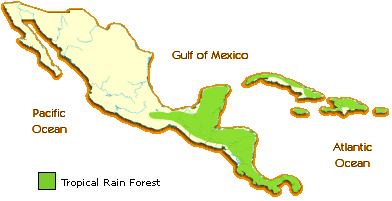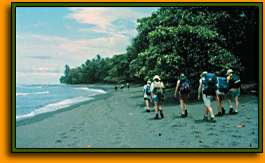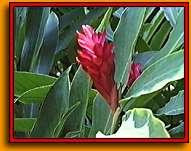C e n t r a l A m e r i c a

The relatively small tropical forests of Central America have a relatively
high diversity of species, since they sit on the land bridge between North
and South America. Tiny Panama is home to more than 700 species of birds, a
larger number than found in all of North America. Costa Rica has made
ecotourism a major source of revenue, and has established a national network
of parks. See Student Correspondents in Costa Rica for Field
Journals and images from the students of Summit High School.
 In 1950, about 60% of Central America was covered with forest, but by 1980
this had fallen to 41%, and El Salvador, the smallest nation in the region,
has almost no forest remaining. This deforestation—though relatively small
in total numbers of acres—is in fact proportionately even more significant
than changes in land use in Brazil or Indonesia, which are much larger both
in national territory and in extent of forest remaining.
In 1950, about 60% of Central America was covered with forest, but by 1980
this had fallen to 41%, and El Salvador, the smallest nation in the region,
has almost no forest remaining. This deforestation—though relatively small
in total numbers of acres—is in fact proportionately even more significant
than changes in land use in Brazil or Indonesia, which are much larger both
in national territory and in extent of forest remaining.
 Many biologists think that the decline in bird species formerly common in
North America, such as the wood thrush or Tennessee warbler, can mainly be
ascribed to the loss of these Central American forests, since three of the
four major flyways from North to South America pass through Panama.
Many biologists think that the decline in bird species formerly common in
North America, such as the wood thrush or Tennessee warbler, can mainly be
ascribed to the loss of these Central American forests, since three of the
four major flyways from North to South America pass through Panama.

|

![]()
 In 1950, about 60% of Central America was covered with forest, but by 1980
this had fallen to 41%, and El Salvador, the smallest nation in the region,
has almost no forest remaining. This deforestation—though relatively small
in total numbers of acres—is in fact proportionately even more significant
than changes in land use in Brazil or Indonesia, which are much larger both
in national territory and in extent of forest remaining.
In 1950, about 60% of Central America was covered with forest, but by 1980
this had fallen to 41%, and El Salvador, the smallest nation in the region,
has almost no forest remaining. This deforestation—though relatively small
in total numbers of acres—is in fact proportionately even more significant
than changes in land use in Brazil or Indonesia, which are much larger both
in national territory and in extent of forest remaining.
 Many biologists think that the decline in bird species formerly common in
North America, such as the wood thrush or Tennessee warbler, can mainly be
ascribed to the loss of these Central American forests, since three of the
four major flyways from North to South America pass through Panama.
Many biologists think that the decline in bird species formerly common in
North America, such as the wood thrush or Tennessee warbler, can mainly be
ascribed to the loss of these Central American forests, since three of the
four major flyways from North to South America pass through Panama.
